Tyson Foods Bundle
Who Really Controls Tyson Foods?
Ever wondered who pulls the strings at one of the world's largest food companies? The ownership structure of Tyson Foods is a fascinating case study in corporate power and family influence. Understanding who owns Tyson Foods can unlock insights into its strategic decisions, its resilience in the face of market challenges, and its long-term vision. From its humble beginnings to its current global footprint, the story of Tyson Foods is deeply intertwined with its ownership.
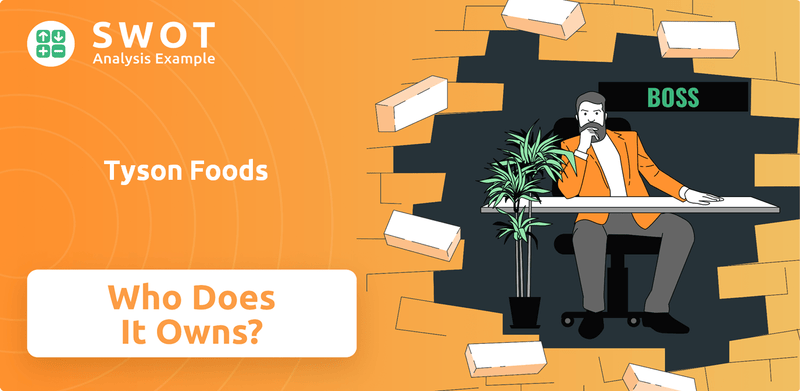
This exploration into Tyson Foods ownership will examine the evolution of its shareholder base, from the founding family's initial stake to the influence of institutional investors and public shareholders. We'll delve into the Tyson Foods company history, tracing the impact of key decisions and the enduring legacy of its leadership. Discover the answers to questions like "Who founded Tyson Foods?" and "Does the Tyson family still own Tyson Foods?" to gain a comprehensive understanding of this food industry giant and its Tyson Foods executives.
Who Founded Tyson Foods?
The story of Tyson Foods began in 1935 with John W. Tyson. He started the business by hauling chickens to markets, using a truck he'd purchased on credit. This marked the humble beginnings of a company that would become a giant in the food industry. The early days were fueled by personal savings and a lot of hard work, setting the stage for the company's future growth.
John W. Tyson's initial focus was on delivering live chickens to cities like Kansas City, St. Louis, and Chicago. This hands-on approach was crucial in establishing the business and understanding the market. In 1947, the business was formally incorporated as Tyson Feed & Hatchery, Inc., expanding its services to include selling baby chicks and feed, and transporting chickens, further solidifying its place in the poultry market.
A pivotal moment came in 1957 when the Tyson family decided to expand rather than sell the business. This decision led to the construction of their own processing plant in 1958, a move that significantly impacted the company's trajectory. This strategic choice demonstrated a commitment to long-term growth and control over their operations.
Don Tyson, John W. Tyson's son, joined the company in 1952 at age 22 and became a key player in the company's expansion. He later became president in 1966. The company's initial public offering (IPO) in 1963 marked a significant milestone.
- John W. Tyson founded the company in 1935, starting with chicken hauling.
- The company went public in 1963, issuing 100,000 shares at $10.50 each.
- Don Tyson played a crucial role in the company's growth, becoming president in 1966.
- John W. Tyson remained CEO until his death in 1967.
Tyson Foods SWOT Analysis
- Complete SWOT Breakdown
- Fully Customizable
- Editable in Excel & Word
- Professional Formatting
- Investor-Ready Format
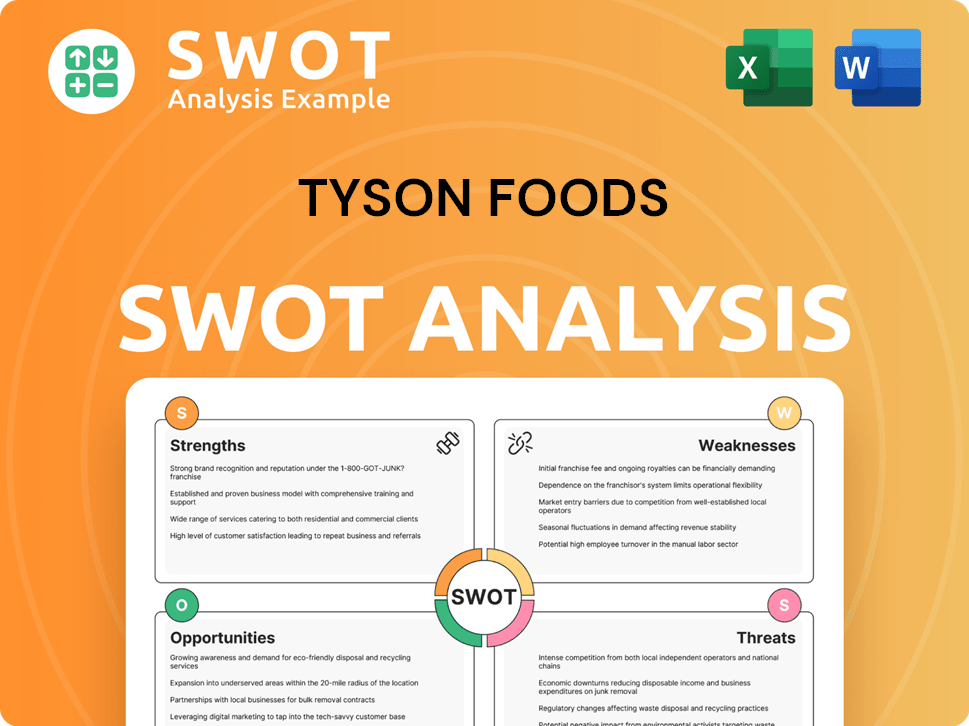
How Has Tyson Foods’s Ownership Changed Over Time?
The evolution of Tyson Foods' ownership structure is marked by the enduring influence of the founding family. Since its IPO in 1963, the company has employed a dual-class share structure, which grants the Tyson family significant control. This structure, with Class B shares holding ten votes per share compared to Class A shares' one vote, has allowed the family to maintain substantial voting power despite holding a smaller portion of the total equity.
The Tyson Limited Partnership (TLP), comprised of Tyson family member trusts, holds nearly 100% of the Class B shares. This gives them approximately 71.74% to 72% of the total voting power as of May 2025. This concentrated voting power enables the family to significantly influence major corporate decisions. The dual-class structure has faced scrutiny, potentially insulating management and the board from the interests of Class A shareholders. The company's revenue for fiscal year 2024 exceeded $53 billion. As of March 29, 2025, Tyson Foods reported total shareholders' equity of $18.531 billion.
| Share Class | Voting Rights | Ownership |
|---|---|---|
| Class A | One vote per share | Publicly Traded |
| Class B | Ten votes per share | Tyson Limited Partnership (TLP) |
| Institutional Investors | Varies | 69.24% of Class A shares (May 2025) |
As of May 2025, institutional investors held a significant portion of Tyson Foods' Class A shares, with their holdings remaining unchanged at 69.24%. Major institutional shareholders include Vanguard Group Inc., BlackRock, Inc., and State Street Corp. Mutual funds' holdings also remained unchanged at 133.96% in May 2025. Insiders, including executives and board members, held 0.55% of Class A shares in May 2025. For instance, as of February 6, 2025, Donnie D. King held 0.14% and Barbara A. Tyson held 0.09% of Class A shares.
Tyson Foods' ownership structure is primarily influenced by the Tyson family through a dual-class share system.
- The Tyson family controls a significant portion of the voting power.
- Institutional investors hold a substantial share of Class A shares.
- The dual-class structure has implications for corporate governance.
- Understanding the ownership is crucial for investors and stakeholders.
Tyson Foods PESTLE Analysis
- Covers All 6 PESTLE Categories
- No Research Needed – Save Hours of Work
- Built by Experts, Trusted by Consultants
- Instant Download, Ready to Use
- 100% Editable, Fully Customizable
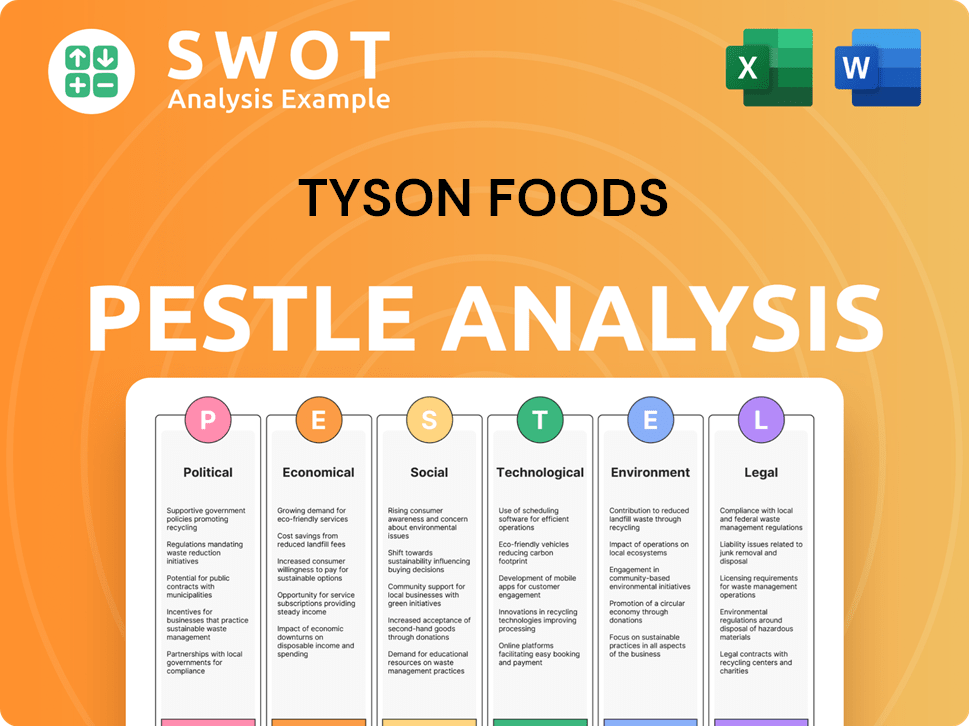
Who Sits on Tyson Foods’s Board?
The corporate governance of Tyson Foods is significantly shaped by its dual-class share structure, which heavily influences voting power. Publicly traded Class A shares grant one vote per share, while Class B shares offer ten votes each. This setup means that the Tyson family, through Tyson Limited Partnership (TLP), controls nearly all Class B shares, which account for roughly 70% of the total voting power. This structure gives the Tyson family considerable influence, allowing them to potentially overrule proposals even if a majority of independent shareholders disagree. Understanding the Tyson Foods ownership structure is key to grasping how decisions are made within the company.
As of the Annual Meeting of Shareholders on February 6, 2025, the board of directors at Tyson Foods consists of 13 members. Nine of these are independent directors. The board members serving a one-year term include Chairman John H. Tyson, Noel White (Executive Vice Chairman), and several others. John H. Tyson and Barbara A. Tyson represent the founding family on the board. This composition reflects the blend of independent oversight and family influence that characterizes Tyson Foods company.
| Board Member | Title | Affiliation |
|---|---|---|
| John H. Tyson | Chairman | Tyson Family |
| Noel White | Executive Vice Chairman | |
| Les R. Baledge | Director | |
| Mike Beebe | Director | |
| Maria Claudia Borras | Director | |
| David J. Bronczek | Director | |
| Donnie King | President and CEO | |
| Maria N. Martinez | Director | |
| Kevin M. McNamara | Director | |
| Cheryl S. Miller | Director | |
| Kate B. Quinn | Director | Chair of the Audit Committee |
| Jeffrey K. Schomburger | Director | |
| Barbara A. Tyson | Director | Tyson Family |
The dual-class structure has led to shareholder concerns and proposals for change. Shareholder resolutions have been filed to address the voting structure, aiming for a one-share-one-vote system. For example, the New York State Common Retirement Fund and the American Baptist Home Mission Societies (ABHMS) have brought forth proposals. The board has generally opposed such resolutions, maintaining that existing disclosures are adequate. This ongoing debate highlights the complexities of Tyson Foods ownership and the balance between family control and shareholder interests. For more insights, you can explore the Brief History of Tyson Foods.
The Tyson family maintains significant control through a dual-class share structure, holding the majority of the voting power.
- Board of Directors: Composed of 13 members, with 9 independent directors as of February 2025.
- Shareholder Proposals: Efforts to address the voting structure and increase transparency have been ongoing.
- Family Influence: John H. Tyson, the grandson of the founder, serves as Chairman, ensuring family representation.
- Voting Power: The Tyson family controls approximately 70% of the voting power through Class B shares.
Tyson Foods Business Model Canvas
- Complete 9-Block Business Model Canvas
- Effortlessly Communicate Your Business Strategy
- Investor-Ready BMC Format
- 100% Editable and Customizable
- Clear and Structured Layout
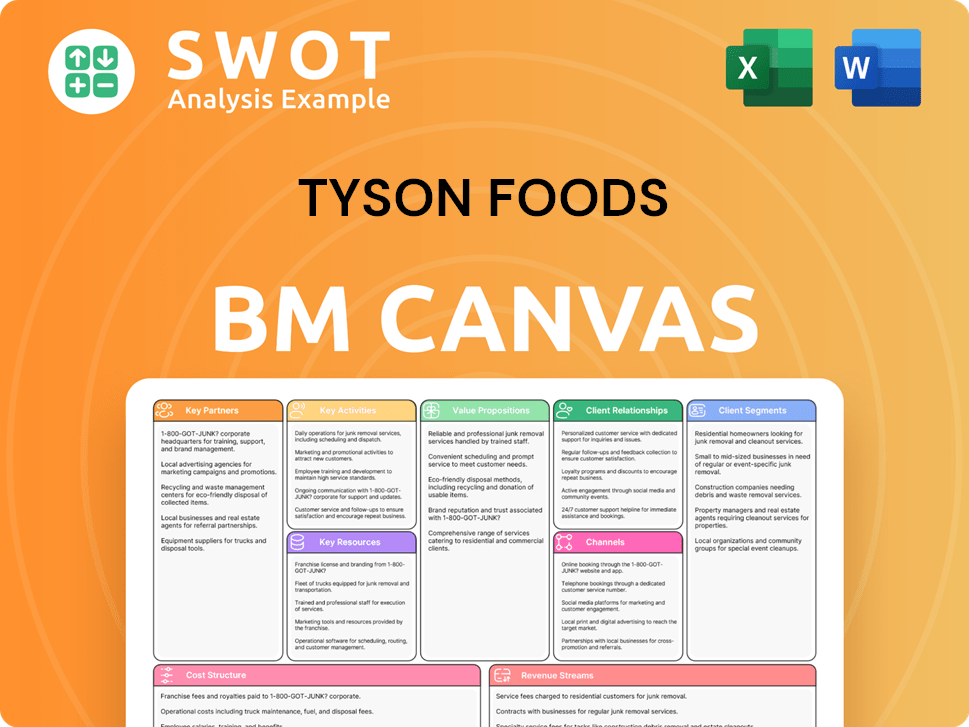
What Recent Changes Have Shaped Tyson Foods’s Ownership Landscape?
In recent years, the ownership structure of Tyson Foods has seen some shifts, despite the continued influence of the Tyson family. The family maintains significant voting control through Class B shares, holding approximately 71.74% to 72% of the voting power. Institutional investors held 69.24% of Class A shares as of May 2025, with mutual funds holding 133.96%. Insider holdings, including executives and board members, stood at 0.55% in May 2025.
Recent insider transactions include sales by Devin Cole, Group President Poultry GBU, and Adam S. Deckinger, General Counsel and Secretary. The company has also engaged in share buyback programs; as of March 29, 2025, 7.3 million shares remained available for repurchase. Quarterly stock buybacks for the period ending March 31, 2025, were reported at $875.63K. Additionally, Tyson Foods declared quarterly dividends of $0.50 per share for Class A common stock and $0.45 for Class B common stock, payable on September 12, 2025. These activities reflect ongoing efforts to manage capital and return value to shareholders.
| Ownership Category | May 2025 | Change |
|---|---|---|
| Institutional Investors (Class A) | 69.24% | Unchanged |
| Mutual Funds | 133.96% | Unchanged |
| Insider Holdings | 0.55% | - |
Tyson Foods has been strategically adjusting its asset portfolio. In 2021, the company sold its pet treats business for $1.2 billion. More recently, in March 2024, it sold its broiler processing plant, hatchery, and feed mill in Dexter, Missouri, to Cal-Maine Foods. These moves are part of a broader plan to optimize operations, which has also involved closing poultry and beef packing plants. These strategic decisions and the ongoing debate about its dual-class structure continue to shape the Tyson Foods ownership landscape.
The Tyson family retains significant voting control through Class B shares, influencing the direction of the company. Institutional investors and mutual funds hold a substantial portion of the company's shares.
Shareholders are advocating for greater transparency in voting results. Concerns about worker rights and corporate accountability are being raised.
The company has engaged in share buyback programs and declared quarterly dividends. Insider transactions have also occurred.
Tyson Foods has sold assets, including its pet treats business and a broiler processing plant. These moves are aimed at streamlining operations.
Tyson Foods Porter's Five Forces Analysis
- Covers All 5 Competitive Forces in Detail
- Structured for Consultants, Students, and Founders
- 100% Editable in Microsoft Word & Excel
- Instant Digital Download – Use Immediately
- Compatible with Mac & PC – Fully Unlocked
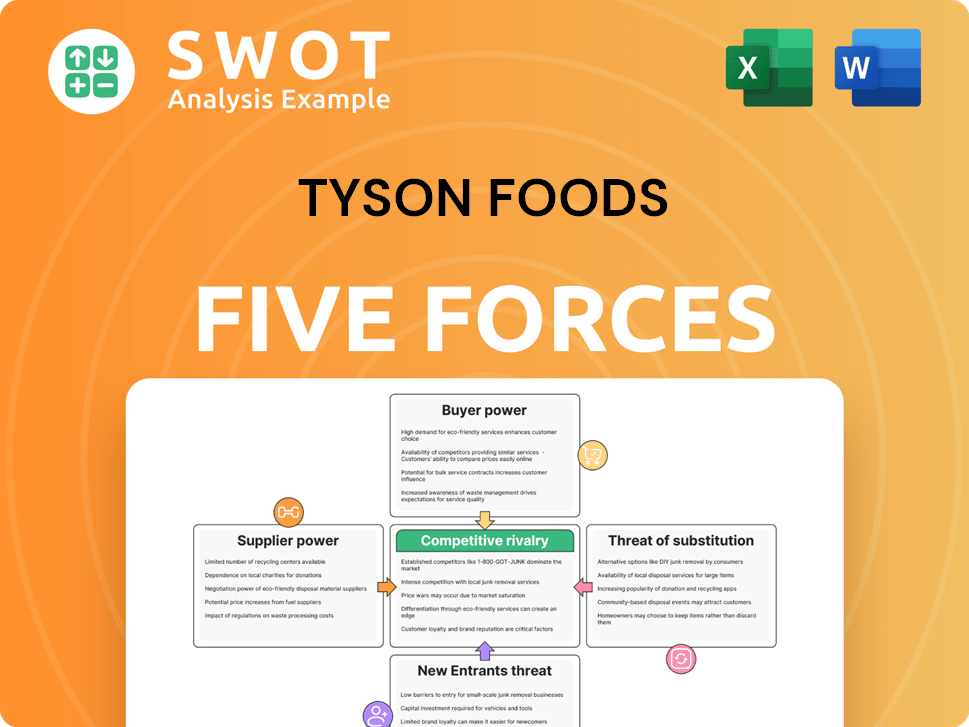
Related Blogs
- What are Mission Vision & Core Values of Tyson Foods Company?
- What is Competitive Landscape of Tyson Foods Company?
- What is Growth Strategy and Future Prospects of Tyson Foods Company?
- How Does Tyson Foods Company Work?
- What is Sales and Marketing Strategy of Tyson Foods Company?
- What is Brief History of Tyson Foods Company?
- What is Customer Demographics and Target Market of Tyson Foods Company?
Disclaimer
All information, articles, and product details provided on this website are for general informational and educational purposes only. We do not claim any ownership over, nor do we intend to infringe upon, any trademarks, copyrights, logos, brand names, or other intellectual property mentioned or depicted on this site. Such intellectual property remains the property of its respective owners, and any references here are made solely for identification or informational purposes, without implying any affiliation, endorsement, or partnership.
We make no representations or warranties, express or implied, regarding the accuracy, completeness, or suitability of any content or products presented. Nothing on this website should be construed as legal, tax, investment, financial, medical, or other professional advice. In addition, no part of this site—including articles or product references—constitutes a solicitation, recommendation, endorsement, advertisement, or offer to buy or sell any securities, franchises, or other financial instruments, particularly in jurisdictions where such activity would be unlawful.
All content is of a general nature and may not address the specific circumstances of any individual or entity. It is not a substitute for professional advice or services. Any actions you take based on the information provided here are strictly at your own risk. You accept full responsibility for any decisions or outcomes arising from your use of this website and agree to release us from any liability in connection with your use of, or reliance upon, the content or products found herein.